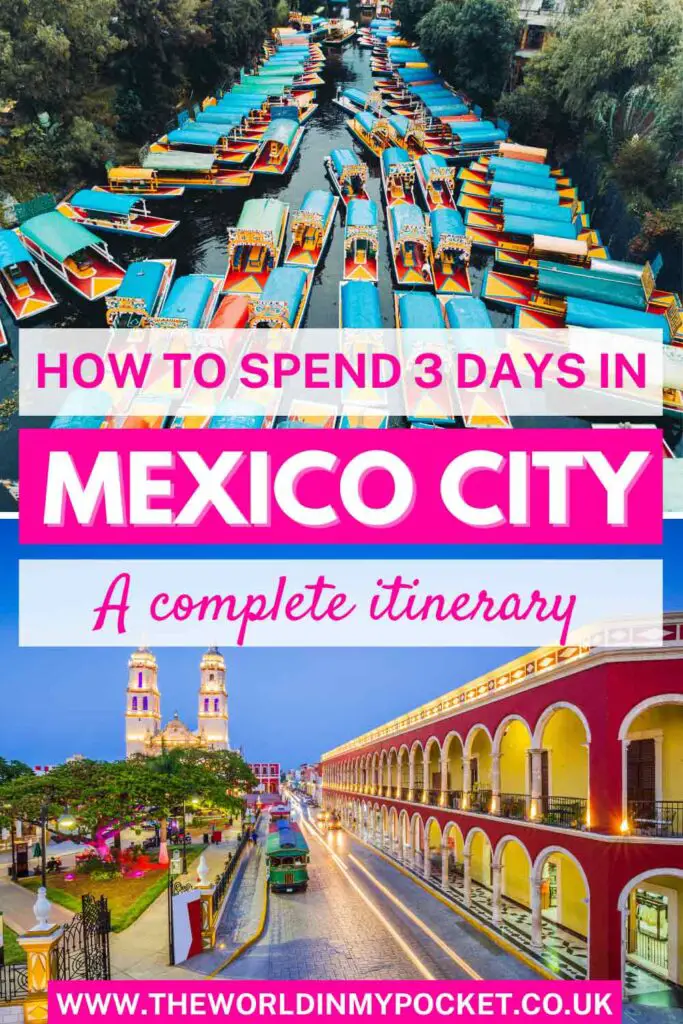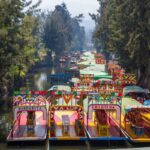Wondering how to spend 3 days in Mexico City? Even though it’s a short time to fully explore this enormous metropolis, 72 hours should give you enough time to see the highlights!
Mexico City is a place where ancient history and modern life blend seamlessly to create a destination like no other.
Whether you’re a history buff, an art enthusiast, a foodie, or just someone looking to soak up the local culture, CDMX has something special in store for you and here’s how to spend 3 days if it’s your first visit.
How to Spend 3 days in Mexico City
Day 1: Exploring the Heart of the City
Zocalo and Historic Landmarks

The Zócalo is a massive public square is surrounded by historic landmarks such as the Metropolitan Cathedral and the National Palace. It’s pretty much what you’d consider the “heart” of Mexico City.
Palacio de Bellas Artes
Next, make your way to the Palacio de Bellas Artes. This breathtaking palace is home to Mexico’s most famous murals, created by artists like Diego Rivera and David Alfaro Siqueiros.
Moreover, you’ll also be amazed by the intricate gilded details and the magnificent stained glass curtain.
As a tip, if you love arts, Palacio de Bellas Artes usually has a pretty interesting repertoire of shows, exhibitions, and more, so make sure you check out their calendar during your time in Mexico City to see if something peaks your interest.
Alameda Central
Just a short walk from the Palacio de Bellas Artes lies Alameda Central, a beautiful public park lined by trees and lush gardens that provide a welcome respite from the bustling city.
Templo Mayor
Your next stop is the Templo Mayor, an ancient Aztec temple located right in the heart of the city. The temple offers a glimpse into Mexico’s rich pre-Hispanic past. Here, you’ll find the impressive Coyolxauhqui Stone, which represents the Aztec goddess of the moon.
Make sure you visit the museum, where you can see fascinating artifacts discovered at the site.
Dine at Balcon del Zocalo
To wrap up your day, head to Balcon del Zocalo, a rooftop restaurant with stunning views of the Zocalo and the Metropolitan Cathedral.
Here, you’ll find an array of Mexican classics with a contemporary twist to them as well as more elaborate dishes with a touch of avant-garde cuisine.
If you’re up for a unique dining experience, make sure you ask for their seasonal menu, which usually includes nine courses of incredibly creative dishes designed by the restaurant’s team.
Day 2: Coyoacan and Xochimilco
Xochimilco Canals

Start your day by making your way to the picturesque Xochimilco Canals, where you can board a trajinera (traditional, flat-bottomed boats) and explore a network of waterways that are the last remnants of a vast water transport system built by the Aztecs that once connected most of the Valley of Mexico.
The canals are lined with chinampas, which are small, rectangular areas of fertile arable land.
Historically, these floating gardens were used by the Aztecs for agriculture and are still in use today, showcasing an ancient agricultural technique. The chinampas are particularly important for the cultivation of flowers and vegetables.
A trip through the Xochimilco canals is often accompanied by the sounds of mariachi bands or marimba music, as musicians travel on separate trajineras, playing for the passengers of other boats.
Frida Kahlo Museum
Next, head over to the nearby Coyoacan neighborhood to explore the famous Frida Kahlo Museum.
Known as the “Casa Azul”, or Blue House, due to its eye-catching indigo walls, you’ll be able to immerse yourself in the world of this famous Mexican artist and gain insight into her tumultuous life.
You’ll find her most iconic works, personal items, and even her studio exactly as it was when she lived there.
Museo Anahuacalli
Next, discover the impressive art collection of Frida’s husband, Diego Rivera at Museo Anahuacalli. This museum is much lesser-known than Frida’s house, but equally worth a visit, especially if you’re on the lookout for a hidden gem.
Anahuacalli was opened with the purpose of honoring Mexican art from pre-Hispanic times to contemporary, as Rivera believed that no distinction should be made between the two and that it’s not about art vs. crafts. For him, everything is art in different styles.
The building that houses the museum is an architectural masterpiece constructed with black volcanic stone by architect Juan O’Gorman, who Rivera commissioned to create a space that would exalt Mexican culture.
Inside, you’ll also find Diego Rivera’s personal collection, which includes thousands of pre-Hispanic objects from household utensils to sculptures, offering a unique view of the culture and worldview of ancient civilizations.
Coyoacan District
Both the Frida Kahlo Museum and Museo Anahuacalli are located in the colorful Coyoacan neighborhood, so it only makes sense to linger for a while in order to get a good feeling of it!
This picturesque neighborhood is characterized by cobblestone streets, colorful houses, and quaint squares. Must-visits include Jardin Centernario, which is the heart and soul of Coyoacan, Mercado de Coyoacan for craft shopping, and Plaza Hidalgo for pretty cafés.
Day 3: Downtown
National Museum of Anthropology
Start your day by heading over to the lush Polanco neighbordhoo to explore one of the most famous museums in Mexico City: The National Museum of Anthropology.
This place boasts an extensive collection of pre-Hispanic art, this must-see museum offers a comprehensive timeline of Mexico’s past.
Chapultepec Park

Chapultepec Park is one of the largest city parks in the world and a place that contains many of Mexico City’s coolest attractions!
During your time here, you can check out the only royal castle in the Americas (Chapultepec Caste) or explore contemporary and modern art at Tamayo Museum.
Condesa and Roma Neighborhoods

End your day by exploring the trendy Condesa and Roma Neighborhoods, both known for their eclectic mix of cafes, restaurants, bars, and boutiques.
You’ll love simply taking a stroll through tree-lined streets enjoying the beautiful architecture, or you can opt to check out a few bars or restaurants for a perfect ending to your 3 days in Mexico City (personal recommendations for bars: Brujas and La Barra del al Lado).
Day Trips and Excursions
If you have more than 3 days in Mexico City or want to change one day on your itinerary so you can explore nearby spots, here are a few recommendations for day trips near Mexico City:
Malinalco
Located 56 miles from Mexico City, Malinalco is a small town that boasts a rich cultural history as it was an important spiritual and military center for the Aztec Empire.
You’ll love walking through its cobblestone streets while you admire its colorful architecture, and make sure not to miss out on hiking to Cuauhcalli Temple, an impressive monolithic structure carved directly into the rock.
San Miguel de Allende

San Miguel de Allende is 170 miles away from Mexico City but still doable as a day trip if you’re willing to start the day early.
This town is famed for its well-preserved colonial architecture, which I guarantee you’ll fall head over heels in love with. Make sure to check out the Parroquia de San Miguel Arcángel, a neo-Gothic church dominating the central plaza, El Jardin, which is a popular town square surrounded by restaurants and cafés, and Fabrica la Aurora, an industrial building turned into an art and design center.
Tepoztlán

A idyllic town located about 50 miles south of Mexico City, Tepoztlán offers an ideal escape from the city’s hustle and bustle.
The main draw of this town is its spectacular archeological site, Tepozteco. The hike to the temple takes approximately an hour, but the bird’s eye view of the town and valley is well worth the effort.
Valle de Bravo
For nature enthusiasts, the beautiful village of Valle de Bravo is a perfect inclusion on your 3 days in Mexico City itinerary.
It’s highlights include Lake Avándaro, perfect for sailing, water-skiing, and kayaking and the Monarch Butterfly Reserve, which is home to millions of monarch butterflies during the winter season.
Taxco

Taxco is a charming colonial town famous for its silver production.
Its winding streets, baroque architecture, and stunning views make a visit worthwhile. While there, don’t miss the Iglesia de Santa Prisca, an impressive church with beautiful Baroque details and the town’s numerous silver shops and galleries.
Grutas de Tolantongo
This incredible site features thermal pools, caves, and a river with turquoise waters where you can spend the day relaxing in these magnificent hot springs while taking in stunning views.
Teotihuacan Pyramids

A must-visit on any Mexico City trip, Teotihuacan Pyramids will transport you back in time to the ancient Mesoamerican civilization.
While here, you’ll be able to marvel at the Pyramid of the Sun and the Pyramid of the Moon while you walk down Avenue of the Dead or better yet, book a hot air balloon flight to take in the site from above!
Essential Travel Tips for Mexico City
Best Time to Visit Mexico City
Weather-wise, the ideal time to visit Mexico City is during the dry season, spanning from November through April.
The city enjoys mild temperatures, with average daytime temperatures ranging from 20-25°C (68-77°F).
This is an excellent time to enjoy outdoor activities, such as exploring the historic center or taking a leisurely walk through one of Mexico City’s many parks.
Rainfall is minimal during the dry season; however, evenings can be cooler, so it is recommended to bring a light jacket.
Crowd-wise, the best time to avoid the heaviest tourist influx is by visiting during the shoulder season, which falls between September and November. During this time, you are more likely to find fewer tourists and better deals on accommodations.
Although there might be more frequent rain showers as Mexico City transitions from its wet season to its dry season, it rarely interferes with sightseeing plans as they usually happen during the afternoons.
Other great times to visit include October and November, as Day of the Dead in Mexico City is magical! Christmas in Mexico City is also really fun and a great cultural experience but you should expect higher prices when it comes to flights, accommodation, and others.
Currency and Payments
The official currency in Mexico City is the Mexican Peso (MXN) and US dollars aren’t generally accepted like they are in Cancun or Cabo.
Most hotels, restaurants, and larger stores accept credit and debit cards. Visa and MasterCard are the most widely accepted. I’ve read on other blogs that American Express isn’t widely accepted, but I’ve never had issues with it anywhere in Mexico City.
Cash is also a popular payment method in Mexico City, especially for street food stalls and local markets, although you’ll find that many do take cards! Carrying a reasonable amount of cash is a good idea, but avoid keeping all your funds in one place to minimize potential loss.
In recent years, mobile payment services like Apple Pay and Google Pay have expanded their coverage in Mexico City. However, their acceptance is still limited to more upscale establishments. It’s always a good idea to verify the accepted payment methods beforehand.
Tip: Avoid exchanging money at the airport, as rates are typically not in your favor. Use ATMs or local exchange offices instead.
Tip 2: When paying with card, if they ask what currency you’d like to use (Mexican peso vs. your currency, always choose Mexican peso as this will give you a much better exchange rate).
Getting Around Mexico City
Metro System
The Mexico City Metro is a popular choice among tourists and locals for its cost-effectiveness and wide network.
With 12 lines and more than 195 stations, it covers a great deal of the city. Single ride tickets cost only 5 Mexican pesos (about 0.25 USD).
You can purchase a rechargeable card for 10 pesos, which you can top up as needed. Keep in mind that the metro can get quite crowded during rush hour – from 7:00 AM to 9:00 AM and 6:00 PM to 8:00 PM and I wouldn’t recommend using it then!
Buses and Tram (Metrobus)
Mexico City offers different kinds of buses:
- RTP Buses: These are regular city buses, which you can identify by their green color. Fares range from 2 to 6 pesos, depending on the route and distance.
- Metrobús: A more modern bus system with dedicated lanes. Metrobús operates in seven distinctive lines and costs 7 pesos. You need a Metrobús card to use this service, which can be purchased at most stations.
Taxis and Ridesharing
Taxis are available throughout Mexico City. However, for safety reasons, I recommend you use authorized taxi services like Taxqueña, Portales, or Sitio. These companies can be recognized by their white cars with a pink stripe on the side.
Ride sharing services like Uber or DiDi are also available and considered a much safer option, though!
Biking
Renting a bike can be a fun, eco-friendly way to explore Mexico City. The city’s bikesharing program, Ecobici, offers short-term passes for tourists.
The system consists of more than 6,000 bikes and 480 stations scattered around the city. Prices for a daily pass start at 110 pesos (you can pay it via the app), with options for weekly or monthly passes as well.
Staying Safe in Mexico City
If you’re wondering if Mexico City is safe, you’ll love to know that it is generally easy-going, but as with any large city, it’s essential to take precautions and be aware of your surroundings.
Here are some safety tips to help make your trip as enjoyable and safe as possible.
General Precautions
- Use reputable transportation options like authorized taxi stands or ridesharing services.
- Be aware of your surroundings, especially in crowded tourist areas and on public transportation.
- Keep a copy of your passport, travel documents, and important phone numbers in a separate location from the originals.
- Pickpocketing can occur in crowded tourist areas such as centro, so keep your belongings secure.
Neighborhood Recommendations
It’s important to know which areas to visit and which to avoid during your stay. Some safe and popular neighborhoods for tourists include Polanco, Condesa, Roma, and Coyoacan.
Avoid high-crime areas, especially at night. These include Tepito, La Merced, Iztapalapa, and Ciudad Nezahualcóyotl.
Best Neighborhoods To Stay In Mexico City
Mexico City offers a diverse range of neighborhoods for visitors to experience, each with their own unique charm and attractions.
Here are my favorite ones for a quick visit due to their central location, safety, and beauty:
Polanco
Polanco is an upscale neighborhood known for its luxurious hotels and high-end shopping.
With the famous Avenida Presidente Masaryk at its heart, visitors will find a mix of international designer brands, boutiques, and elegant dining options.
Polanco is also home to numerous art galleries and museums, with Museo Soumaya and Museo Jumex being notable highlights. Ideal for those seeking a stylish and sophisticated stay.
Roma Norte
Roma Norte is a vibrant and bohemian neighborhood that has become increasingly popular for its laid-back atmosphere and diverse cultural scene.
Renowned for its tree-lined streets, colorful architecture, and array of trendy cafes, bars, and restaurants, Roma Norte is perfect for if you’re looking to experience Mexico City’s contemporary lifestyle.
Condesa
Condesa is known for its vibrant nightlife and dining scene, Condesa is ideal for those seeking a lively social atmosphere.
The neighborhood boasts beautiful art deco architecture and green spaces such as Parque México and Parque España, which provide visitors with a refreshing retreat from the bustling city streets.
Cuauhtémoc

Cuauhtémoc is a central neighborhood that hosts some of Mexico City’s most famous landmarks, including Paseo de la Reforma and The Angel of Independence.
Serving as the city’s financial district, the area offers modern high-rise hotels and upscale dining options.
Coyoacán
Coyoacán is a charming neighborhood with a rich history and a strong sense of community. Visitors will discover cobblestone streets, picturesque plazas, and colorful markets such as the Mercado de Coyoacán.
The neighborhood is also home to several historical attractions, including the Frida Kahlo Museum and Casa Estudio Diego Rivera y Frida Kahlo. Perfect for those interested in experiencing authentic Mexican culture and history.
Best Hotels in Mexico City
Zocalo Central (Centro)
Zocalo Central is a great choice if you’re looking for a blend of history and modernity. The hotel is located right in Mexico City’s bustling Zocalo Square, so it offers easy access to numerous attractions including the Templo Mayor and Mexico City Cathedral. Click here to read the reviews and here to see the latest rates.
The Wild Oscar (Polanco)
If chic Polanco sounds more like your Jam, the Wild Oscar is a perfect choice. This hotel offers a unique boutique hotel experience and it stands out for its exceptional service, intimate atmosphere, and its incredibly aesthetic design. Click here to read the reviews and here to see the latest rates.
3 Days in Mexico City: FAQs
What are the must-see attractions while spending three days in Mexico City?

In three days in Mexico City, you can experience a mix of history, culture, and art.
Don’t miss the historic Zócalo (the main square), the Mexico City Metropolitan Cathedral, and the National Palace. Head to the impressive Chapultepec Castle, the National Museum of Anthropology, and Frida Kahlo’s Blue House. For a splash of modern architecture, visit the Soumaya Museum, and explore the artsy neighborhoods of Roma and Condesa.
What are some budget-friendly activities for a 3-day visit to Mexico City?
Walking tours around the historic center and browsing the vibrant markets like Mercado de la Merced or Coyoacán Market are great budget-friendly options. Free attractions include Chapultepec Park, exploring the neighborhoods of Roma and Condesa, and window shopping around Masaryk. Many museums, including the Soumaya Museum, also offer free entry on Sundays.
What are the best areas to stay for a quick three-day trip to Mexico City?
For first-time visitors, consider staying in the historic center (Centro Histórico) as it’s close to many tourist attractions. The neighborhoods of Polanco and Condesa offer great accommodation options and are well-connected to other parts of the city. Roma is another popular choice for travelers seeking a trendy neighborhood with boutique hotels and hip cafes.
How should I prepare for a weekend visit to Mexico City, and what safety tips should I follow?
Pack clothes appropriate for the mild climate and wear comfortable shoes for walking. Stay aware of your surroundings, use Uber to get around, and avoid withdrawing money from ATMs during nighttime.
For more similar articles, check out my recommendations below:
- The Ultimate 5 Day Yucatan Itinerary in Mexico
- Traditional Mexican Food You Can’t Miss on Your Next Trip to Mexico
- 7 of the Best Restaurants in Merida Mexico According to a Local
- Unique Places to Visit in Mexico
Like it? Pin it!

Disclaimer: Some of the links on this website are “affiliate links.” This means that if you click on the link and do a purchase, I will receive an affiliate commission at no extra cost for you. This helps me keep my website running and continue to share my travelling knowledge with you. I thank you for booking your flights or hotels using the links on my website. Regardless, I only recommend products or services I use personally and believe will add value to my readers.




